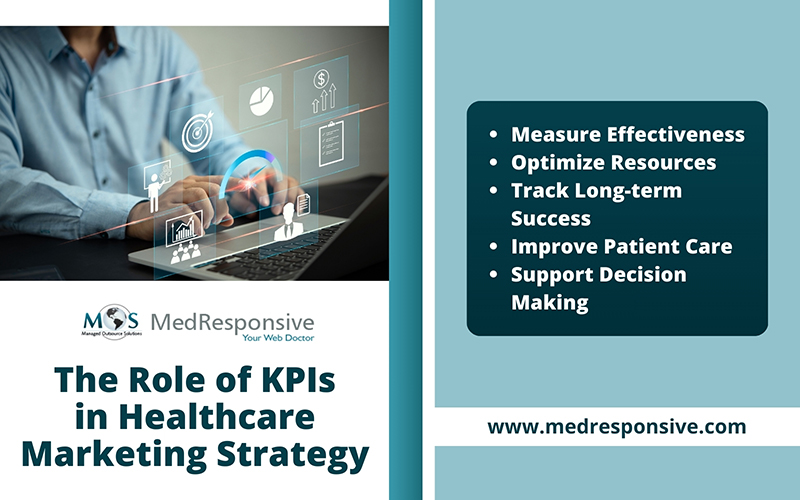Healthcare organizations invest in content marketing, PPC ads, and search engine optimization (SEO) strategies to attract new patients and boost profitability. While these methods are proven to be effective, their impact can vary according to the organization’s goal, target audience, and overall marketing approach. So how do healthcare providers determine the success of their online advertising efforts?
By tracking important indicators known as healthcare marketing KPIs (Key Performance Indicators), health institutions can gauge the effectiveness of their online campaigns. These healthcare marketing metrics are crucial in aligning marketing strategies with practice goals and patient needs. As measuring these important criteria in-house requires expert knowledge and time, practices can utilize digital marketing for healthcare services as a practical solution.
What Are Healthcare KPIs and Why Do Healthcare Organizations Use It?
A healthcare KPI or key performance indicator refers to the set of metrics that is used to observe, analyze, and measure the effectiveness of the marketing efforts in the healthcare industry. These metrics help organizations understand how well their campaigns, strategies, and services are performing.
Unlike traditional marketing, online advertising allows for precise and real-time data tracking, enabling businesses to accurately assess whether their goals are being met. The objectives of healthcare marketing are distinct as it involves building trust, promoting quality care, and establishing long-term relationships with patients. As a result, tracking the impact of online campaigning with KPI is essential due to the reasons mentioned below:
- Measure Effectiveness: KPIs allow healthcare organizations to assess the effectiveness of their marketing efforts. By tracking key metrics such as patient acquisition rate or conversion rate, practices can determine which campaigns and channels deliver the best results. These are essential healthcare marketing metrics that show whether marketing tactics are truly impacting the bottom line.
- Optimize Resources: While comparatively lesser than traditional methods, digital healthcare marketing budgets can be substantial. Organizations must ensure that they are spending their financial resources wisely by measuring KPIs such as Cost per Acquisition (CPA) and Return on Investment (ROI in healthcare). By tracking cost-effectiveness of each marketing campaign with these metrics, businesses can adjust their budgets for maximum impact.
- Track Long-term Success: Healthcare marketing is not just about short-term gains. Key metrics like Brand Impression and Patient Referral Rate can provide a long-term view into how an organization is building their reputation and nurturing relationships. These insights are crucial for sustainable growth, competitive positioning and support how to measure ROI in medical marketing campaigns over time.
- Improve Patient Care: Healthcare organizations can gain direct insights into patient experiences by measuring metrics such as Patient Satisfaction and Net Promoter Score (NPS). This feedback helps them identify areas for improvement, which is crucial for maintaining a loyal patient base and encouraging referrals.
- Support Decision Making: KPIs provide healthcare organizations with the information they need to take data-driven, strategic decisions. Whether it’s choosing which marketing channels to focus on, or deciding how much budget to allocate for digital marketing, KPIs ensure decisions are based on facts rather than guesswork.
Key Metrics That Drive Healthcare Marketing Performance
Healthcare advertising is all about attracting, engaging, and enhancing patient experience. To assess whether your marketing efforts are yielding the desired results, it’s crucial to track specific metrics that provide insights into various stages of the patient journey. Here are some key medical marketing metrics that matter the most:
- Patient Acquisition Metrics
Patient acquisition metrics are vital to track patient acquisition and retention for long-term growth. These include:
- New Patient Inquiries: The number of new patient leads generated through marketing efforts.
- Patient Conversion Rate: The percentage of inquiries or leads that convert into actual patients.
- Patient Acquisition Cost (PAC): The financial investment associated with acquiring a new patient, considering all marketing expenses such as salaries, tools, and website maintenance.
- Lead-to-Appointment Rate: The ratio of leads that actually schedule an appointment or consultation.
- Website and Digital Engagement Metrics
Most patients start their search for healthcare providers online, which is why gauging the performance of websites and other digital platforms is essential. Digital metrics showcase how effectively your online presence is working in reaching new audiences.
- Website Traffic: Total visits to your website, including page views and sessions.
- Bounce Rate: The percentage of single-page session users, indicating the amount of patients who leave your healthcare website after viewing only one page.
- Average Session Duration: How long visitors stay on the site, which can indicate engagement levels.
- Click-through Rate (CTR): The percentage of people who click on a particular link or call-to-action (CTA) compared to how many saw the link.
- Engagement Rate: Likes, comments, shares, and other user interactions relative to the number of followers or impressions.
- Follower Growth Rate: The rate at which your social media followers or subscribers are increasing across various platforms.
These metrics provide insight into how effectively your online presence is engaging with and attracting potential patients.
- Patient Retention and Referral Metrics
While attracting new patients is essential, retaining them and encouraging referrals from existing patients is just as important. Strong patient retention and referral metrics help determine how well relationships are maintained with patients and whether they’re recommending your practice to others.
- Patient Retention Rate: The percentage of patients who return for follow-up visits or services after their initial appointment.
- Referral Rate: The number of new patients referred by current patients, indicating how effective your patient relationships are.
- Patient Satisfaction Score (PSS): This score often gathered through surveys, reflects how satisfied patients are with their entire journey—from scheduling an appointment to receiving care. It can be a strong predictor of both retention and referral rates.
- Net Promoter Score (NPS): A metric used to gauge patient loyalty by asking them how likely they are to recommend your practice to others.
Tracking retention and referral metrics helps ensure that your practice is not just bringing in new patients, but keeping them coming back and sharing your services with others.
- Return on Investment Metrics
Ultimately, you want to know whether your marketing spend is delivering tangible results. ROI measures the profitability of your marketing campaigns.
- ROI of Marketing Campaigns: The return generated from marketing investments, calculated by comparing the revenue generated by a campaign to its cost. A positive ROI indicates that the campaign was profitable, while a negative ROI suggests it wasn’t.
- Referral Conversion Rate: The percentage of visitors referred to your practice that ultimately converts into patients. This metric helps evaluate how effectively your referral sources are turning leads into actual appointments or treatments.
- Funnel Analysis: Analyzing the patient journey to identify where potential patients drop off, from the initial contact to booking an appointment or treatment. This helps pinpoint areas in the process that may need improvement to increase conversions.
- Cost per Lead (CPL): The cost of acquiring a single lead through various healthcare marketing activities, calculated by dividing the total marketing spends by the number of leads generated. This helps measure the efficiency of your lead generation efforts.
These metrics are vital to understand whether your marketing efforts are financially worthwhile and for making data-driven decisions as necessary.
Analyze Marketing Efforts with Outsourcing Solutions
Healthcare providers can outsource to companies offering healthcare marketing services to save on the long-term investment, required resources, and time needed to track the metrics effectively. While measuring KPIs in-house provides greater control and transparency, it may hinder your team from delivering quality care. Outsourcing services present as a reliable solution for medical organizations to handle the complexities involved in healthcare analytics. These specialized service providers have the technical expertise and tools required to accurately track, collect, and report on campaign performance. By entrusting this task to a third-party company, practices can take evidence-based decisions to optimize their campaigns and position themselves for long term success in the healthcare industry.
Want to improve your healthcare marketing strategy?
Discover how tracking the right metrics can help you achieve your goals.





